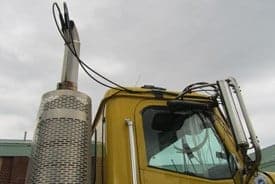Kids and dogs understand the force of air, when they stick their hands and heads out of moving cars only to feel them pushed back. It may be invisible, but air is like a see-through net dragging a vehicle back as it strains to move forward.
But researchers at the University of Florida’s Applied Physics Research Group have discovered a novel way to direct the flow of air around cars, trucks and airplanes, which could reduce drag while making vehicles safer, more fuel-efficient and quieter at the same time.
The group works with plasma actuators, a relatively new area of research, said Subrata Roy, associate professor of mechanical and aerospace engineering and founding director of the group. In Roy’s laboratory, doctoral researcher Mark Riherd and his associates discovered that a simple change in geometry – from linear in shape to serpentine – makes plasma actuators more efficient at moving air around a vehicle in motion.
Traditional actuators function much like spoilers on automobiles, which work passively. Roy said the new actuators work actively, responding to the airflow.
The actuators in the Applied Physics Research Group’s laboratory consist of at least two sets of electrodes, with one on top and the other on bottom of an insulating material. When the electrodes are powered, the discharge creates an electrical field, generating plasma. The plasma interacts with the flow of air, allowing the actuator to control it, and that is an area of keen interest to researchers.
Other adaptations to actuators are cumbersome, but plasma actuator geometries can be changed easily, allowing for comparisons of different shapes. Riherd found that switching a linear plasma actuator to a serpentine plasma actuator changes airflow dramatically and offers other benefits as well.
“We’d really like to show that these are very, very versatile actuators,” said Riherd, whose research on serpentine plasma actuators appears in the Journal of Applied Physics. “These are good for more than one application.”
For example, Riherd said, in designing an airplane wing, instead of using six or seven different actuators for six or seven functions, a serpentine actuator could be installed to perform several functions over the course of a flight.
Research into plasma’s applications has increased in the last 10 years, Roy and Riherd said. Plasma is one of the four states of matter, in addition to solids, liquids and gases. Although Earth is an oasis of solids, liquids and gases, 99 percent of the remainder of the universe, including the sun, is made up of plasmas.
Plasmas consist of charged particles of positive ions and negative electrons or ions, and are conductive, responding to electrical and magnetic fields, Roy said. One of the most common manifestations of plasma is in lightning and in neon signs. Riherd said one of the advantages of plasma actuators is that they are fully electronic with no moving parts. They also respond quickly when turned on and have a low mass, making them useful at smaller scales, such as with nanosatellites and microsatellites, another research effort of Roy’s group.
Riherd said one application is for controlling the separation of airflow over a vehicle. Imagine, he said, holding your hand out of the window of a moving car. If your hand is horizontal, the wind doesn’t jostle it much. But as you bring your hand into a vertical position, the wind jerks your hand back. The jerk is the flow of air separating over your hand, and it produces drag.
While other actuators distribute airflow in one direction, the serpentine plasma actuator distributes airflow in three directions, producing greater benefits.
“No other actuator can do this,” Roy said.
Roy said the serpentine actuators could soon be used for vehicles such as trucks and cars. Cargo trucks with flat surfaces produce a tremendous amount of drag, Roy said. Rather than trying to reshape a fleet, the trucks could be retrofitted with actuators that control the airflow over the vehicle.
“At low speeds, you can bend the flow as you need it, providing much more control,” Roy said.
In aircraft, Riherd said, the serpentine actuator may not only save fuel but also reduce flight noise, an advantage for aircraft flying over populated areas. Riherd said he thinks future vehicle manufacturers will like the serpentine actuators.
“These actuators are very rapid in their response to flow; they respond almost instantaneously, in a millisecond,” Riherd said. “They use a low amount of power, just a few watts, and you can make them any shape you want, and make them really tiny.
“You can use them anywhere you can get wires to them to power them.”




